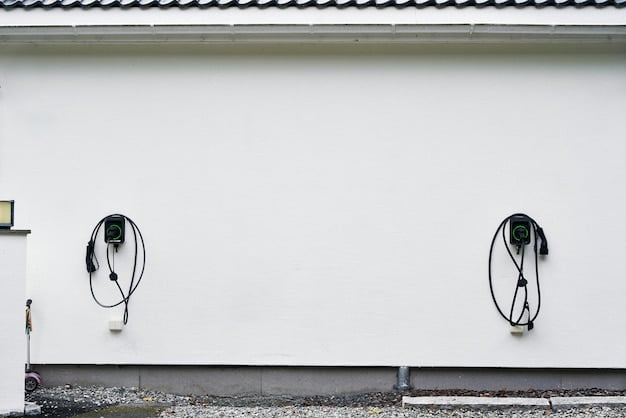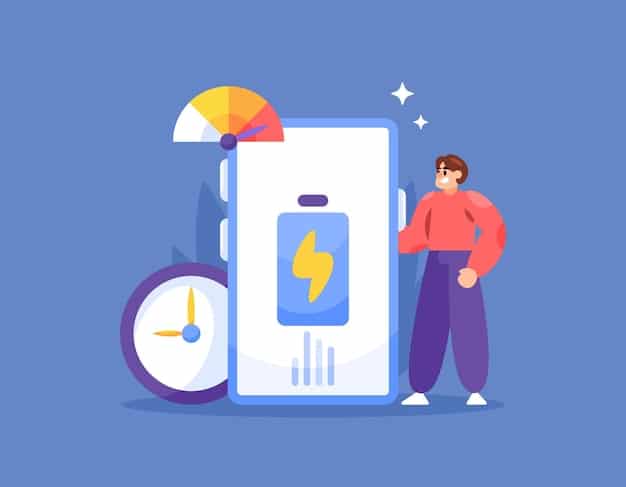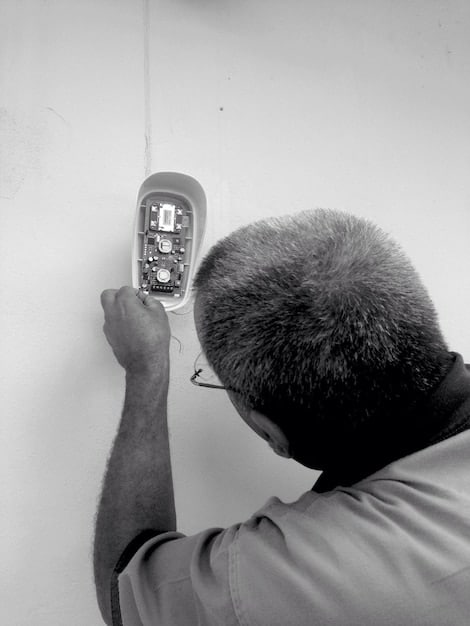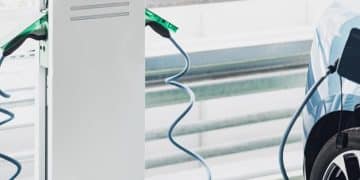Electric Vehicle Charging at Home: Your Complete Guide

Electric vehicle charging at home offers convenience and potential cost savings, but understanding installation requirements, charger types, and incentives is essential for a smooth transition.
So, you’re considering an electric vehicle? Great choice! But have you thought about how you’ll keep it charged? This guide breaks down everything you need to know about electric vehicle charging at home, from installation to saving money.
Understanding Your EV Charging Needs
Before diving into installation and costs, it’s crucial to understand your specific charging needs. This depends on factors like your driving habits, the type of EV you own, and your desired charging speed. Let’s explore these aspects.
Assessing Your Daily Driving
Start by estimating your average daily commute and weekly mileage. Most EVs offer a range sufficient for daily commutes, meaning you might only need to charge overnight to replenish the used battery capacity.
EV Battery Capacity and Range
Consider the battery size (kWh) and range (miles) of your EV. A larger battery offers more range but requires more time to charge fully. Knowing your EV’s specifications helps determine the appropriate charger level for your needs.

The following considerations will help you to determine the best charger level for your needs.
- Level 1 Charging: Standard 120V outlet, adding 2-5 miles of range per hour. Suitable for plug-in hybrids or those with very short commutes.
- Level 2 Charging: 240V outlet, adding 12-35 miles of range per hour. The most common home charging solution, ideal for fully electric vehicles and faster replenishment.
- DC Fast Charging: High-power charging stations (480V) found in public locations, adding 60-80 miles of range in 20 minutes. Not typically installed at home due to high costs and electrical requirements.
Understanding your driving needs and EV specifications is the first step in choosing the right home charging solution. This will help you determine the charging speed and voltage required for your situation, ultimately affecting installation costs and convenience.
Choosing the Right Charger for Your Home
Selecting the appropriate charger for your home is a balance between charging speed, budget, and electrical capacity. There are two main types to consider: Level 1 and Level 2 chargers, each with its own advantages and disadvantages.
Level 1 Chargers: The Basics
Level 1 chargers come standard with most EVs. They plug into a regular 120V household outlet, making them convenient for anyone with access to an outlet near their parking space.
Level 2 Chargers: Faster Charging
Level 2 chargers require a 240V electrical circuit, similar to those used for dryers or ovens. They offer significantly faster charging speeds compared to Level 1, making them a popular choice for EV owners.
The following list includes factors to consider to determine the best choice for your home.
- Charging Speed: Level 2 chargers can add 12-35 miles of range per hour, while Level 1 chargers only add 2-5 miles.
- Installation Requirements: Level 2 chargers require professional installation, which can add to the overall cost.
- Cost: Level 1 chargers are less expensive upfront since they don’t require installation, but Level 2 chargers offer long-term convenience and faster charging.
Choosing the right charger depends on your individual needs and circumstances. Level 1 chargers are suitable for those with short commutes or plug-in hybrids, while Level 2 chargers are a worthwhile investment for EV owners seeking faster charging times and greater convenience.
Home EV Charger Installation: A Step-by-Step Guide
Installing an EV charger at home involves careful planning and execution to ensure safety and compliance with local electrical codes. Here’s a step-by-step guide to help you through the process.
Assessing Your Electrical Panel Capacity
The first step is to assess your home’s electrical panel capacity. An EV charger requires a dedicated circuit, and your panel must have sufficient capacity to handle the additional load.
Hiring a Qualified Electrician
Unless you’re a licensed electrician, it’s crucial to hire a qualified professional for the installation. A qualified electrician can assess your electrical system, recommend the appropriate charger size, and ensure the installation meets all safety requirements.

Consider the following safety steps before installing a charger at home.
- Permits and Inspections: Check with your local authorities about required permits and inspections for EV charger installations.
- Wiring and Circuit Protection: Ensure the wiring and circuit protection are appropriately sized for the charger’s amperage to prevent overloading and fire hazards.
- Safety Features: Look for chargers with built-in safety features like overcurrent protection, surge protection, and automatic shut-off.
Proper installation is paramount for the safe and efficient operation of your home EV charger. By following these steps and working with a qualified electrician, you can ensure a smooth and reliable charging experience for your electric vehicle.
Understanding the Costs of Home EV Charging
Switching to an electric vehicle can lead to significant cost savings, but it’s essential to understand the costs associated with home EV charging. These costs include charger price, installation fees, and electricity consumption.
Charger Price and Installation Costs
The cost of an EV charger varies depending on the level (1 or 2), features, and brand. Level 1 chargers are typically less expensive since they don’t require installation, while Level 2 chargers can range from $400 to $1000 or more.
Electricity Consumption and Utility Rates
The cost of electricity to charge your EV depends on your local utility rates and your charging habits. Charging during off-peak hours, when electricity rates are lower, can significantly reduce your charging costs.
Here are some tips to help you figure out potential cost savings.
- Off-Peak Charging: Many utility companies offer time-of-use rates, with lower electricity prices during off-peak hours (typically overnight).
- Energy Efficiency: Choose energy-efficient EV chargers and optimize your charging habits to minimize energy waste.
- Solar Power: Consider combining your EV charging with solar panels to further reduce your reliance on grid electricity and lower your carbon footprint.
Understanding the costs associated with EV charging is essential for making informed decisions and maximizing your savings. By considering charger price, installation fees, electricity consumption, and available incentives, you can effectively manage your charging expenses and enjoy the long-term benefits of electric vehicle ownership.
Maximizing Savings with EV Charging Incentives and Rebates
One of the significant benefits of owning an electric vehicle is access to various incentives and rebates that can help offset the costs of purchasing and installing a home charger. These incentives are offered by federal, state, and local governments, as well as utility companies.
Federal Tax Credits for EV Chargers
The federal government offers a tax credit for the purchase and installation of qualified EV chargers. This credit can significantly reduce the upfront costs of installing a Level 2 charger at home.
State and Local Rebates and Incentives
Many states and local governments offer rebates and incentives for EV chargers, which can be combined with federal tax credits for even greater savings. These incentives vary by location, so it’s essential to research what’s available in your area.
Research the following incentive programs in your area to find even more savings.
- Utility Company Programs: Many utility companies offer rebates or incentives for EV charger installations to encourage EV adoption and manage grid load.
- Home Efficiency Programs: Some areas offer home efficiency programs that include incentives for EV charger installations as part of broader energy-saving initiatives.
- Online Resources: Websites like the U.S. Department of Energy’s Alternative Fuels Data Center provide searchable databases of incentives and rebates for EVs and chargers.
Taking advantage of available incentives and rebates can significantly reduce the cost of installing a home EV charger, making electric vehicle ownership more affordable. By researching and applying for these programs, you can enjoy the financial benefits while contributing to a cleaner transportation future.
Future-Proofing Your Home EV Charging Setup
As electric vehicle technology evolves, it’s essential to future-proof your home charging setup. This means considering factors like charger compatibility, smart charging features, and potential upgrades to ensure your charging infrastructure remains relevant and efficient for years to come.
Charger Compatibility and Standards
Ensure your chosen charger is compatible with current and future EV models. The SAE J1772 connector is the standard for Level 1 and Level 2 charging in North America, but newer EVs may adopt different charging standards.
Smart Charging Features for Grid Optimization
Consider chargers with smart charging features that allow you to schedule charging times, monitor energy consumption, and participate in grid optimization programs. These features can help you save money and reduce your environmental impact.
Think about the following strategies to help future-proof your home EV setup.
- Over-the-Air Updates: Choose chargers that support over-the-air software updates to ensure compatibility with the latest EV models and charging protocols.
- Scalability: Consider the potential for future EV purchases and choose a charging setup that can be easily scaled up to accommodate multiple vehicles.
- Battery Storage Integration: Explore the possibility of integrating battery storage systems with your EV charger to store excess energy from solar panels and further reduce your reliance on the grid.
Future-proofing your home EV charging setup is a smart investment that will pay off in the long run. By considering charger compatibility, smart charging features, and potential upgrades, you can ensure your charging infrastructure remains relevant, efficient, and compatible with evolving EV technology.
| Key Point | Brief Description |
|---|---|
| ⚡ Charger Types | Level 1 (slow), Level 2 (faster), DC Fast Charging (public only). |
| 💰 Cost Factors | Charger price, installation, electricity use, and potential incentives. |
| 💡 Installation | Assess capacity, hire an electrician, obtain permits, and ensure safety. |
| 🌞 Savings | Use off-peak charging, incentives, and consider solar power. |
Frequently Asked Questions
Level 2 charging is significantly faster, adding 12-35 miles of range per hour, while Level 1 typically adds only 2-5 miles per hour. This makes Level 2 ideal for fully electric vehicles.
Yes, in most locations, you’ll need a permit to install a Level 2 charger. Check with your local authorities for specific requirements and ensure the installation meets local electrical codes.
Off-peak charging hours are periods when electricity demand is lower, typically overnight. Utility companies often offer lower rates during these times, allowing you to save money by charging your EV overnight.
Yes, the federal government offers a tax credit for the purchase and installation of qualified EV chargers. This credit can help offset the upfront costs of installing a Level 2 charger at home; check current guidelines for specifics.
It’s strongly discouraged to use a regular extension cord for charging your EV, as it can be a fire hazard due to the high amperage draw. Always use a dedicated circuit and a properly rated EV charger cable.
Conclusion
Investing in electric vehicle charging at home is a smart move for any EV owner, offering convenience, cost savings, and a more sustainable lifestyle. By understanding your charging needs, choosing the right charger, and taking advantage of available incentives, you can enjoy the benefits of electric vehicle ownership while minimizing your environmental impact.





